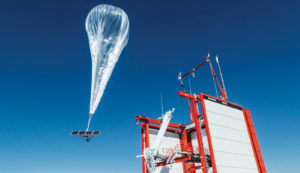
For many, internet access is common and logging in is second nature. But more than half of the world’s population is still without access. Google is committed to remedy this and has developed Project Loon, a network of balloons that can provide internet coverage to people in rural and remote locations.
It works like this: High-speed internet is transmitted up to the nearest balloon from a telecommunications partner on the ground, relayed across the Project Loon network, and then back down to users. Google has been able to transmit data between balloons more than 62 miles apart in the stratosphere and back down to earth with connection speeds of up to 10 Mbps, directly to LTE phones.
Made from sheets of polyethylene, the balloons are designed to survive more than 100 days as high as 12.5 miles up in the stratosphere. There they can withstand winds of 62 mph, intense UV radiation and temperature swings that can reach as low -130° F.
 The technology includes the components of a cell tower redesigned to fit the Project Loon balloon. The equipment is powered by renewable energy, with solar panels for daytime operation and a battery for nighttime use.
The technology includes the components of a cell tower redesigned to fit the Project Loon balloon. The equipment is powered by renewable energy, with solar panels for daytime operation and a battery for nighttime use.
Project Loon is proving to be a lifesaver in natural disasters. In the wake of the devastation from Hurricane Maria in Puerto Rico, Google worked with the Government of Puerto Rico, the FCC, the FAA, ATT and a range of spectrum partners to deliver emergency internet service, including text messaging and online access to some of the hardest hit parts of the island. For more details, visit www.x.company/loon.
 TEXTILES.ORG
TEXTILES.ORG


